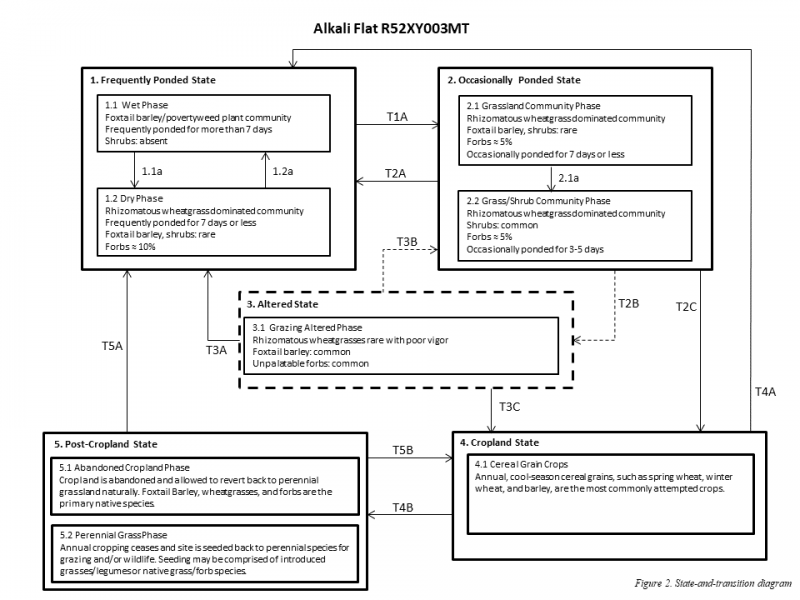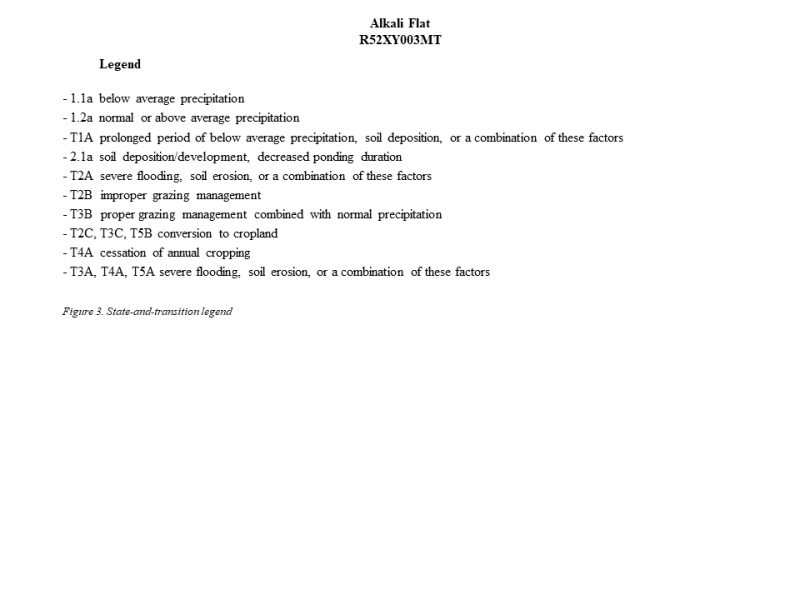
Natural Resources
Conservation Service
Ecological site R052XY003MT
Alkali Flat (Af)
Last updated: 6/26/2019
Accessed: 12/20/2025
General information
Provisional. A provisional ecological site description has undergone quality control and quality assurance review. It contains a working state and transition model and enough information to identify the ecological site.
MLRA notes
Major Land Resource Area (MLRA): 052X–Brown Glaciated Plains
The Brown Glaciated Plains, MLRA 52, is an expansive and agriculturally and ecologically significant area. It consists of around 14.5 million acres and stretches across 350 miles from east to west, encompassing portions of 15 counties in north-central Montana. This region represents the southwestern limit of the Laurentide Ice Sheet and is considered to be the driest and westernmost area within the vast network of glacially derived prairie pothole landforms of the northern Great Plains. Elevation ranges from 2,000 feet (610 meters) to 4,600 feet (1,400 meters).
Soils are primarily Mollisols, but Entisols, Inceptisols, Alfisols, and Vertisols are also common. Till from continental glaciation is the predominant parent material, but alluvium and bedrock are also common. Till deposits are typically less than 50 feet thick, and in some areas glacially deformed bedrock occurs at or near the soil surface (Soller, 2001). Underlying the till is sedimentary bedrock largely consisting of Cretaceous shale, sandstone, and mudstone (Vuke et al., 2007). It is commonly exposed on hillslopes, particularly along drainageways. Significant alluvial deposits occur along glacial outwash channels and major drainages, including portions of the Missouri, Teton, Marias, Milk, and Frenchman Rivers. Large glacial lakes, particularly in the western half of the MLRA, deposited clayey and silty lacustrine sediments (Fullerton et al., 2013).
Much of the western portion of this MLRA was glaciated towards the end of the Wisconsin age, and the maximum glacial extent occurred approximately 20,000 years ago (Fullerton et al., 2004). The result is a geologically young landscape that is predominantly a level till plain interspersed with lake plains and dominated by soils in the Mollisol and Vertisol orders. These soils are very productive and generally are well suited to dryland farming. Much of this area is aridic-ustic. Crop-fallow dryland wheat farming is the predominant land use. Areas of rangeland typically are on steep hillslopes along drainages.
The rangeland, much of which is native mixedgrass prairie, increases in abundance in the eastern half of the MLRA. The Wisconsin-age till in the north-central part of this area typically formed large disintegration moraines with steep slopes and numerous poorly drained potholes. A large portion of Wisconsin-age till occurring on the type of the level terrain that would typically be optimal for farming has large amounts of less-suitable sodium-affected Natrustalfs. Significant portions of Blaine, Phillips, and Valley Counties were glaciated approximately 150,000 years ago during the Illinoisan age. Due to erosion and dissection of the landscape, many of these areas have steeper slopes and more exposed bedrock than areas glaciated during the Wisconsin age (Fullerton and Colton, 1986).
While much of the rangeland in the aridic-ustic portion of MLRA 52 is classified as belonging to the “dry grassland” climatic zone, sites in portions of southern MLRA 52 may belong to the “dry shrubland” climatic zone. The dry shrubland zone represents the northernmost extent of the big sagebrush (Artemisia tridentata) steppe on the Great Plains. Because similar soils occur in both southern and northern portions of the MLRA, it is currently hypothesized that climate is the primary driving factor affecting big sagebrush distribution in this area. However, the precise factors are not fully understood at this time.
Sizeable tracts of largely unbroken rangeland in the eastern half of the MLRA and adjacent southern Saskatchewan are home to the Northern Montana population of greater sage-grouse (Centrocercus urophasianus), and large portions of this area are considered to be a Priority Area for Conservation (PAC) by the U.S. Fish and Wildlife Service (U.S. Fish and Wildlife Service, 2013). This population is unique among sage grouse populations because many individuals overwinter in the big sagebrush steppe (dry shrubland) in the southern portion of the MLRA and then migrate to the northern portion of the MLRA, which lacks big sagebrush (dry grassland), to live the rest of the year (Smith, 2013).
Areas of the till plain near the Bearpaw and Highwood Mountains as well as the Sweetgrass Hills and Rocky Mountain foothills are at higher elevations, receive higher amounts of precipitation, and have a typic-ustic moisture regime. These areas have significantly more rangeland production than the drier aridic-ustic portions of the MLRA and have enough moisture to produce crops annually rather than just bi-annually, as in the drier areas. Ecological sites in this higher precipitation area are classified as the moist grassland climatic zone.
Classification relationships
NRCS Soil Geography Hierarchy
• Land Resource Region: Northern Great Plains
• Major Land Resource Area (MLRA): 052 Brown Glaciated Plains
• Climate Zone: N/A
National Hierarchical Framework of Ecological Units (Cleland et al., 1997; McNab et al., 2007)
• Domain: Dry
• Division: Temperate Steppe
• Province: Great Plains-Palouse Dry Steppe Province 331
• Section: Northwestern Glaciated Plains 331D
• Subsection: Montana Glaciated Plains 331Dh
• Landtype association/Landtype phase: N/A
National Vegetation Classification Standard (Federal Geographic Data Committee, 2008)
• Class: Mesomorphic Shrub and Herb Vegetation Class (2)
• Subclass: Shrub & Herb Wetland Subclass (2.C)
• Formation: Salt Marsh Formation (2.C.5)
• Division: Sarcobatus vermiculatus - Allenrolfea occidentalis - Schoenoplectus americanus North American Interior Brackish Marsh, Playa & Shrubland Division (2.C.5.Nd)
• Macrogroup: Warm & Cool Desert Alkali-Saline Marsh, Playa & Shrubland Macrogroup (2.C.5.Nd.1)
• Group: Distichlis spicata - Puccinellia lemmonii - Salicornia spp. Alkaline-Saline Marsh & Playa Group (2.C.5.Nd.1.a)
• Alliance: No existing correlation
• Association: No existing correlation
EPA Ecoregions
• Level 1: Great Plains (9)
• Level 2: West-Central Semi-Arid Prairies (9.3)
• Level 3: Northwestern Glaciated Plains (42)
• Level 4: North Central Brown Glaciated Plains (42o) & Glaciated Northern Grasslands (42j)
Ecological site concept
This provisional ecological site occurs in all climatic zones of MLRA 52. Figure 1 illustrates the distribution of this ecological site based on current data. This map is approximate, is not intended to be definitive, and may be subject to change. Alkali Flat is an ecological site of limited extent occurring throughout MLRA 52 on playas and lake plains where clay and salts have accumulated.
The distinguishing characteristic of this site is soils that contain accumulated salts and are ponded for long periods, typically for 7 days or more. Soils for this ecological site are typically very deep (more than 60 inches) and derived from clayey alluvium or glaciolacustrine deposits. Soil textures in the upper 4 inches are typically clay or silty clay and have a clay content greater than 45 percent. Soils typically have an ochric epipedon and distinct slickensides (USDA-NRCS, 2016) in the underlying horizons. Characteristic vegetation is foxtail barley (Hordeum jubatum), western wheatgrass (Pascopyrum smithii), and povertyweed (Iva axillaris). Typically, shrubs are rare on this site, but some phases may support greasewood (Sarcobatus vermiculatus), Gardner’s saltbush (Atriplex gardneri), and silver sagebrush (Artemisia cana).
Associated sites
| R052XY092MT |
Saline Subirrigated (Ssb) The Saline Subirrigated site is adjacent to the Alkali Flat site. It is in higher topographic positions, commonly in drainageways or on lake plains adjacent to depressions. |
|---|---|
| R052XY010MT |
Dense Clay (DC) Dry Grassland The Dense Clay Dry Grassland site is on lake plains adjacent to the Alkali Flat site. It is in higher topographic positions that do not receive additional water rather than in depressions. |
| R052XY707MT |
Dense Clay (DC) Dry Shrubland The Dense Clay Dry Shrubland site is on lake plains adjacent to the Alkali Flat site. It is in higher topographic positions that do not receive additional water rather than in depressions. |
| R052XY012MT |
Dense Clay Sodic (Dcsd) Dry Grassland The Dense Clay Sodic Dry Grassland site is on lake plains adjacent to the Alkali Flat site. It is in higher topographic positions that do not receive additional water rather than in depressions. |
| R052XY708MT |
Dense Clay Sodic (Dcsd) Dry Shrubland The Dense Clay Sodic Dry Shrubland site is on lake plains adjacent to the Alkali Flat site. It is in higher topographic positions that do not receive additional water rather than in depressions. |
Similar sites
| R052XY010MT |
Dense Clay (DC) Dry Grassland Dense Clay Dry Grassland differs from the Alkali Flat site in that it does not receive additional moisture from surface runoff and does not contain accumulated salts in the upper 20 inches of soil. It is also well drained and does not pond water for long durations. |
|---|---|
| R052XY707MT |
Dense Clay (DC) Dry Shrubland Dense Clay Dry Shrubland differs from the Alkali Flat site in that it does not receive additional moisture from surface runoff and does not contain accumulated salts in the upper 20 inches of soil. It is also well drained and does not pond water for long durations. |
| R052XY012MT |
Dense Clay Sodic (Dcsd) Dry Grassland Dense Clay Sodic Dry Grassland differs from the Alkali Flat site in that it does not receive additional moisture from surface runoff. It is well drained and does not pond water for long durations. |
| R052XY708MT |
Dense Clay Sodic (Dcsd) Dry Shrubland Dense Clay Sodic Dry Shrubland differs from the Alkali Flat site in that it does not receive additional moisture from surface runoff. It is well drained and does not pond water for long durations. |
| R052XY092MT |
Saline Subirrigated (Ssb) Saline Subirrigated differs from the Alkali Flat site in that it is well drained and does not pond water for long periods of time. It receives additional moisture from ground water rather than surface water and supports more shrubs. |
| R052XY091MT |
Saline Overflow (Sov) Saline Overflow differs from the Alkali Flat site in that it occurs in drainageways and flood plains rather than depressions. It is well drained and does not pond water for long durations even though it does receive additional moisture from surface runoff. |
Table 1. Dominant plant species
| Tree |
Not specified |
|---|---|
| Shrub |
Not specified |
| Herbaceous |
Not specified |
Click on box and path labels to scroll to the respective text.


